Hearty Ham and Cheese Strata: The Best Overnight Breakfast Casserole
This savory ham and cheese strata recipe delivers a rich, hearty flavor and an irresistibly puffy, pillowy, and moist texture that will truly delight your taste buds. It’s the perfect comforting dish you’ve been craving, whether for a special breakfast, a festive brunch, or even a cozy weeknight dinner.
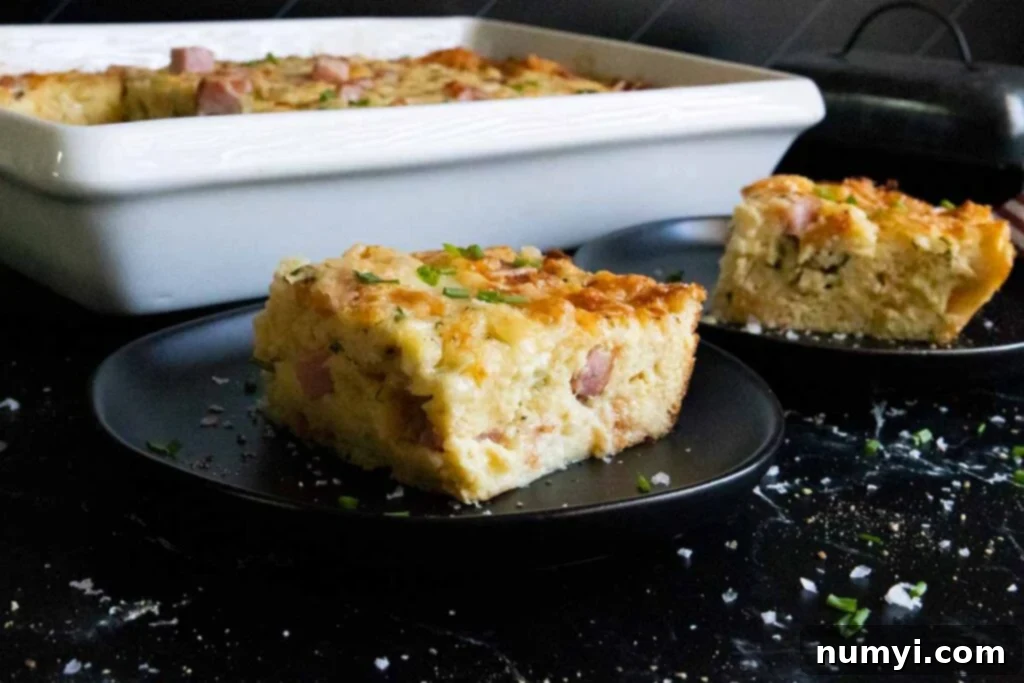
Don’t Sweat The Recipe is supported by its readers. We may earn a commission if you purchase through a link on our site. Learn more.
Why You’ll Love This Savory Ham and Cheese Strata
While there are countless ham breakfast recipes available, this ham and cheese strata stands out. It’s a casserole designed to impress your family and guests with its superb flavor and incredible ease of preparation. This recipe elevates the classic combination of ham and cheese into a truly unforgettable culinary experience.
Imagine tender bread cubes, perfectly soaked in a rich, eggy custard, generously mixed with savory smoked ham and a luxurious blend of nutty Gruyère and sharp Pecorino Romano cheeses. This combination creates a symphony of flavors and textures that takes this breakfast strata to an entirely new level of deliciousness.
- Effortless Overnight Preparation: This ham and cheese breakfast casserole is a true lifesaver for busy mornings. Assemble it the night before, and simply pop it into the oven when you’re ready to bake. It’s perfect for entertaining a crowd, especially during the hectic holiday season, making your morning stress-free.
- Superior Texture: The beauty of this strata lies in its magnificent texture. You’ll discover a wonderfully soft, moist, and chewy interior where the bread has fully absorbed the creamy custard, complemented by deliciously crispy, golden-brown edges. Each bite offers a satisfying contrast that keeps you coming back for more.
- Versatile & Make-Ahead Marvel: This isn’t just a breakfast dish! It serves beautifully as a hearty brunch, a satisfying lunch, or even a comforting light dinner. Its make-ahead nature means you can prepare it hours in advance, allowing the flavors to meld and develop, saving you precious time during those busy holiday gatherings or weekend brunches.
- Ideal for Leftovers: Have leftover baked ham from a holiday feast? This strata is the perfect solution! It’s also an excellent way to use up day-old bread, whether it’s Italian bread, sourdough, crescent rolls, croissants, or dinner rolls. This recipe truly helps minimize food waste while creating something spectacular.
We found ourselves with an abundance of day-old bread after testing an Italian bread recipe (don’t worry, that recipe is coming soon!). It seemed like the perfect opportunity to experiment with strata, and the results were beyond our expectations.
What Exactly is Strata?
A strata is essentially a savory layered casserole, similar to a bread pudding but typically featuring a more structured and substantial profile. It’s built upon a foundation of bread (day-old bread works best as it readily absorbs the liquid without becoming soggy), which is then generously combined with an egg custard, various cheeses, and often meats like ham or sausage, and vegetables.
The term “strata” itself is Italian for “layers,” although the dish as we know it today is a beloved American comfort food. While sweet bread puddings are soaked in sugary custards and often served for dessert, a savory strata uses a rich, cheesy egg mixture, making it ideal for breakfast, brunch, or even dinner. The key differentiator is the overnight soak, which allows the bread to thoroughly absorb the custard, resulting in that delightful, tender, and moist interior rather than just soft bread.

Key Ingredients for a Delicious Ham and Cheese Strata
Creating an exceptional ham and cheese strata starts with high-quality ingredients. Each component plays a crucial role in developing the rich flavor and perfect texture of this breakfast casserole. For a comprehensive list of quantities and detailed instructions, please refer to the full recipe card below.
- Bread – The foundation of your strata! Any leftover day-old loaf bread will work wonderfully. Using slightly stale bread is key because it absorbs the eggy custard much better than fresh bread, preventing a soggy outcome. We highly recommend using a sturdy Italian bread for its texture and flavor, but sourdough, challah, or even croissants can be fantastic choices. You can either tear the bread into rustic 1-inch pieces for a more varied texture or cut them into neat 1-inch cubes. We personally prefer the torn method for a more homey feel.
- Onion – Diced and sautéed, onions add a subtle sweetness and aromatic depth that elevates the overall flavor profile of the dish, making it hearty enough for any meal.
- Unsalted Butter – Used for sautéing the onions, unsalted butter allows you to control the total salt content of your dish while adding a lovely richness to the sautéed vegetables.
- Smoked Ham – The star of the show! Cooked, diced smoked ham brings a wonderful savory and smoky element. This is an ideal recipe for using up leftover holiday ham, such as from Christmas or Easter. Avoid thin deli ham slices, as they tend to disappear into the casserole; instead, opt for thicker, more substantial cubes. It’s a perfect way to transform holiday leftovers into an amazing breakfast for your overnight guests.
- Gruyere cheese – This is where the magic happens! Gruyère cheese, with its distinct nutty, slightly sweet, and earthy flavor, adds an incredible depth and complexity that truly sets this strata apart. It melts beautifully, creating a creamy texture throughout. It absolutely beats plain cheddar cheese for this sophisticated strata.
- Pecorino Romano – Or Parmesan, but we enthusiastically recommend Pecorino Romano for its sharper, saltier, and more piquant flavor. It provides a wonderful counterpoint to the sweetness of the ham and the nuttiness of the Gruyère, enhancing the overall savory profile.
- Fresh Chives (optional)– For an extra layer of mild onion flavor and a pop of fresh green color, fresh diced chives are a delightful addition. If chives aren’t available, thinly sliced green onions (scallions) can be used as a substitute.
- Dried Thyme – A classic herb that pairs perfectly with ham and cheese. If you prefer using fresh thyme, remember to double the amount for equivalent flavor, as dried herbs are more concentrated.
- Dried Ground Mustard – Don’t skip this! Dry mustard is a secret ingredient that adds a unique, subtle tang and a slight kick, enhancing all the other savory flavors without making the dish taste “mustardy.”
- Whole Milk – Using whole milk provides a richer and creamier base for the egg custard, contributing significantly to the dish’s luxurious texture and flavor.
- Heavy Cream – Taking the richness even further, heavy cream ensures the custard is incredibly decadent and smooth, making every bite an indulgence.
- Kosher salt and Ground Black Pepper– These essential seasonings are used to balance and enhance all the wonderful flavors in your ham and cheese strata. Adjust to your taste preferences.
How to Make the Perfect Ham and Cheese Strata Recipe
Making this ham and cheese breakfast strata is surprisingly straightforward, especially since we simplify the assembly. Instead of meticulously layering the bread with cheese and ham, we opt for a more rustic and equally delicious approach: folding all the ingredients together in a large bowl, much like you would for a savory bread pudding. This method ensures an even distribution of all the savory components throughout the casserole.
- Begin by preparing your aromatic base. In a small skillet, melt the two tablespoons of unsalted butter over medium heat. Add the diced onions and sauté them gently for approximately 8 to 10 minutes, or until they are beautifully softened and translucent. This step is crucial for developing a sweet, savory foundation. Once softened, remove the skillet from the heat and allow the onions to cool completely – this prevents the eggs from scrambling when combined later. While the onions cool, take a moment to butter a 9×13 casserole dish thoroughly. This ensures your strata won’t stick and will release easily for serving. Set the prepared dish aside. In a large mixing bowl, combine the torn bread pieces (or neatly cut bread cubes), the diced smoked ham, and the cooled sautéed onions. Toss these ingredients lightly to ensure an even distribution and to help further cool the onions. Next, add 1 1/2 cups of the shredded Gruyère cheese and all of the grated Pecorino Romano cheese. Toss again to thoroughly combine all the solid ingredients.
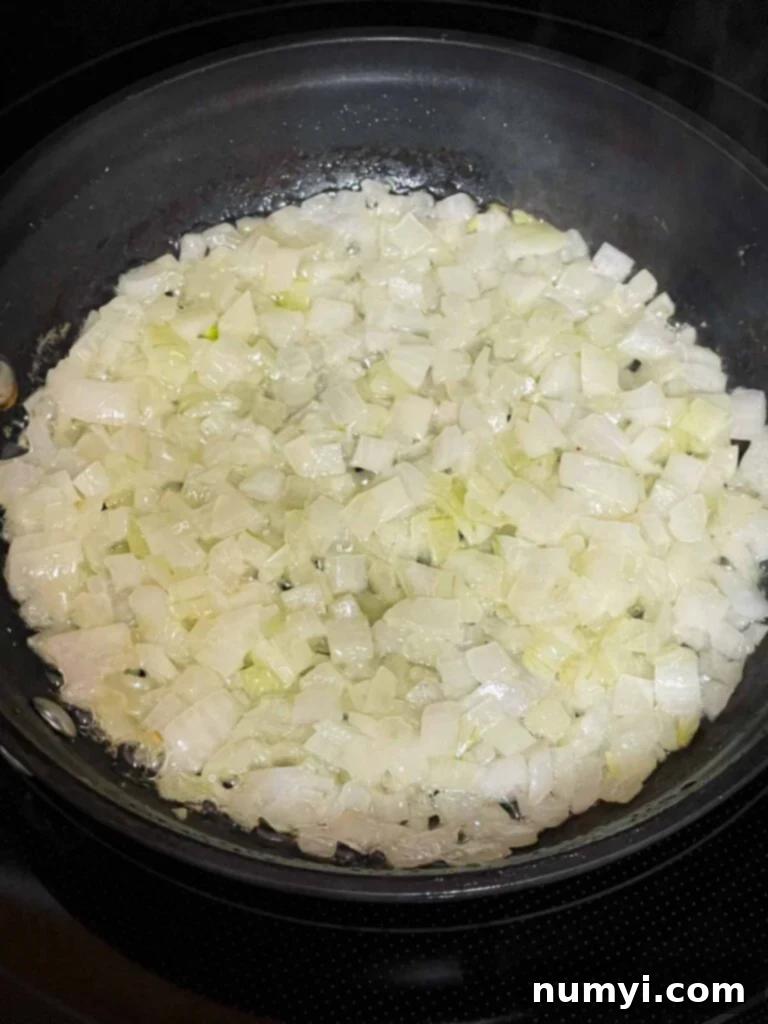
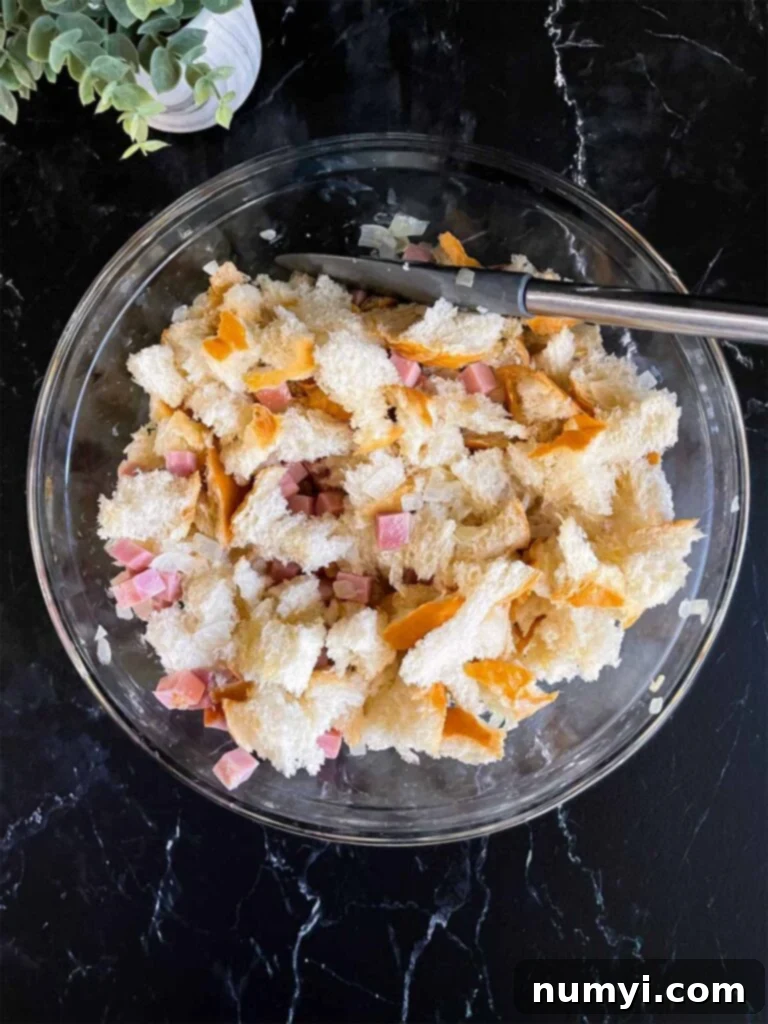
- In a separate, medium-sized bowl, prepare the rich egg custard. Whisk together the large eggs, whole milk, heavy cream, fresh chives, dried thyme, dried ground mustard, kosher salt, and ground black pepper until all ingredients are thoroughly combined and the mixture is smooth. This creamy blend will be absorbed by the bread, creating the strata’s signature moist and tender texture. Carefully pour this flavorful egg mixture evenly over the bread, ham, and cheese mixture in the large bowl. Gently fold all the ingredients together with a spatula, ensuring that every piece of bread is well coated and submerged in the custard. Transfer the entire mixture into the previously buttered 9×13 baking pan, spreading it evenly and smoothing the top. Once transferred, cover the baking dish tightly with plastic wrap. This step is critical: refrigerate the strata overnight, or for a minimum of 6 hours. This extended chilling time allows the bread to fully soak up the egg custard, preventing a dry or crumbly result and creating that irresistible custardy texture when baked.
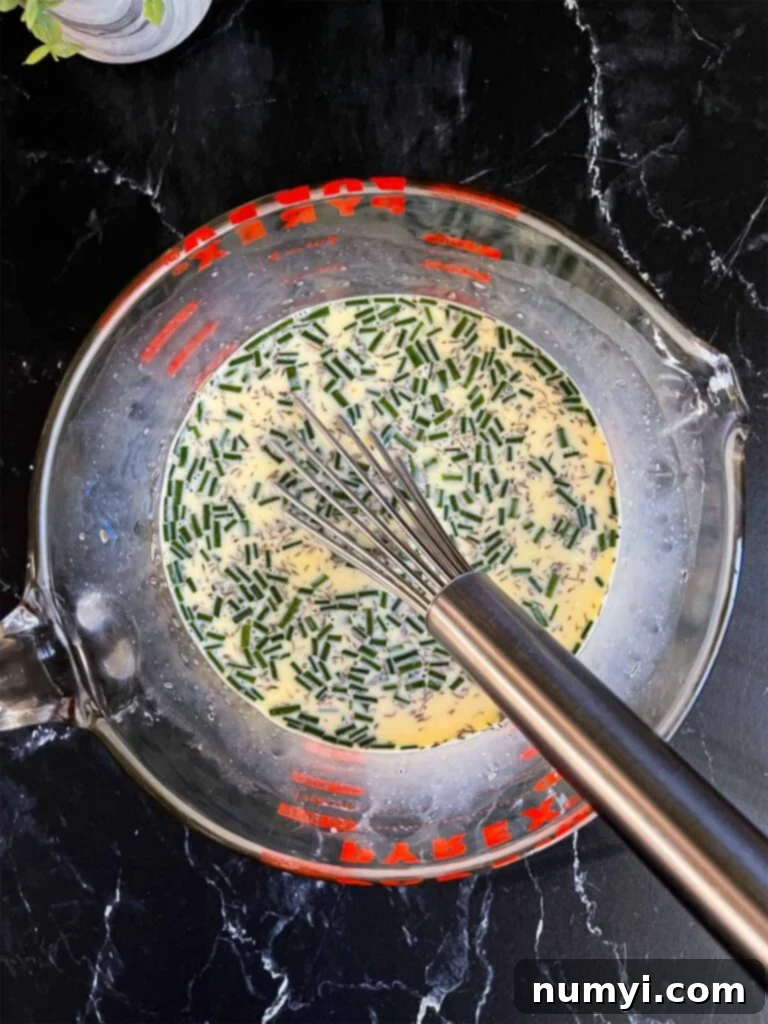
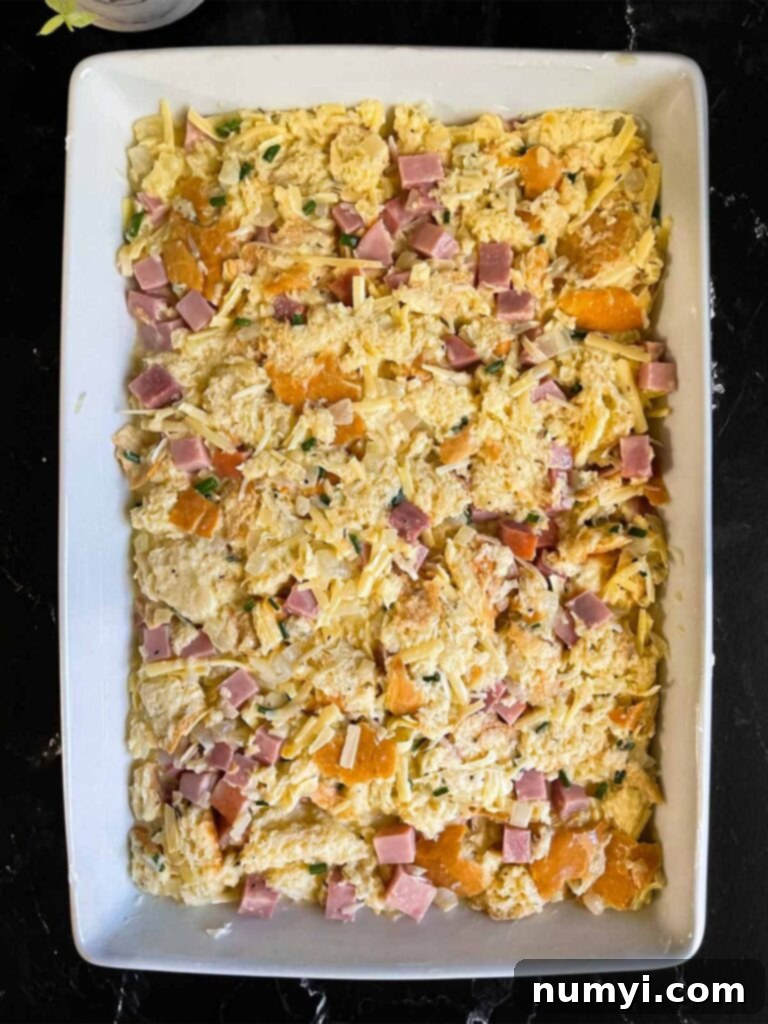
- Before baking your delightful strata, it’s important to allow it to come to room temperature. Remove the covered baking dish from the refrigerator and let it sit on the counter for at least 30 minutes. This helps ensure even baking. While it’s resting, preheat your oven to 350 degrees F (175 degrees C). Once the strata has rested, remove the plastic wrap and carefully cover the baking dish with aluminum foil. To prevent any cheese from sticking to the foil during baking, lightly spray the underside of the aluminum foil with nonstick cooking spray.
- Carefully place the covered baking dish into the preheated oven. Bake for 30 minutes with the foil cover on. This initial covered baking helps to steam the strata, ensuring a moist interior and allowing it to puff up beautifully. After 30 minutes, remove the foil and continue baking for an additional 30 minutes, or until the ham and cheese strata is gorgeously lightly browned, visibly puffed up, and a knife inserted into the center comes out clean, indicating it’s fully cooked through. Allow the strata to cool on a wire rack for 15 minutes before slicing and serving. This resting period is essential for the strata to set properly, making it easier to cut into neat, delicious portions.
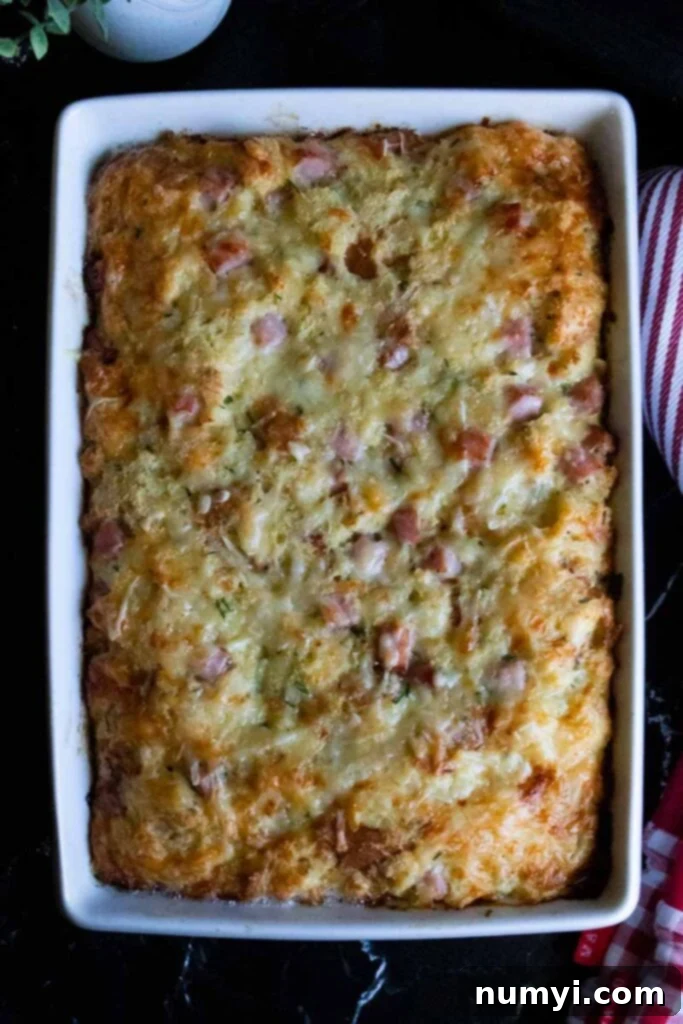
Tips for the Best Ham and Cheese Strata
Achieving the perfect strata is simple with a few helpful pointers. Follow these tips to ensure your breakfast casserole is moist, flavorful, and a true crowd-pleaser every time:
- Embrace Gruyère Cheese: While you can use other cheeses, the Gruyère truly makes this ham and egg bake sing! Its distinctive nutty and slightly sweet flavor adds unparalleled depth and sophistication. If you absolutely don’t care for Gruyère, Swiss cheese is the closest alternative, offering a similar mild, nutty profile and good melting qualities. For a sharper flavor, a mix of sharp cheddar and mozzarella can also work.
- Strategic Cheese Placement: You have a choice here! You can mix all the cheese into the bread and ham mixture before adding the custard, or you can reserve about 1/2 cup of the shredded Gruyère to sprinkle over the top during the last 15-20 minutes of baking. We’ve tried it both ways and slightly prefer the little bit of extra melted, golden-brown Gruyère crust on top for added texture and visual appeal.
- Prevent Sticking with Foil Spray: If you choose to sprinkle cheese on top, remember to lightly spray the underside of your aluminum foil with nonstick cooking spray before covering the dish for the initial bake. This prevents the melted cheese from sticking to the foil, ensuring a beautiful, cheesy crust.
- Rest for Perfect Slices: It’s tempting to dive right in, but allowing the casserole to cool for about 15 minutes after baking is crucial. This resting period allows the strata to set, making it much easier to slice into clean, firm portions without it falling apart.
- Checking for Doneness: You’ll know your strata is perfectly cooked when it’s lightly browned and visibly puffed up. For a more precise check, gently jiggle the pan – if the center is set and doesn’t appear liquidy, it’s done. Alternatively, insert a knife or thin skewer into the center; if it comes out clean, your strata is ready.
- The Importance of Day-Old Bread: For the best results, use day-old or slightly stale bread. Fresh bread can absorb too much liquid and become soggy. If you only have fresh bread, you can lightly toast it in the oven for 10-15 minutes at 300°F (150°C) to dry it out, or simply leave it exposed to air overnight.
- Customization Options: Feel free to customize your strata! Add sautéed mushrooms, bell peppers, or spinach for extra veggies. Instead of ham, cooked breakfast sausage or crumbled bacon works wonderfully. A pinch of cayenne pepper or a dash of hot sauce in the egg mixture can add a delightful spicy kick.
Frequently Asked Questions About Ham and Cheese Strata
The overnight soak is a crucial step for achieving the perfect texture in your ham and cheese strata. When the bread cubes sit in the egg custard mixture for several hours, they have ample time to fully absorb the liquid. This absorption process is what transforms the bread into a rich, moist, and custardy interior, rather than a dry or crumbly one. It also allows all the savory flavors from the ham, cheeses, onions, and seasonings to meld and deepen, resulting in a more harmonious and delicious casserole. This make-ahead aspect is what makes strata a fantastic dish for holiday mornings, weekend brunches, or even a convenient weeknight dinner, as all the prep work is done in advance.
To store leftover ham and cheese strata, first ensure it has cooled completely to room temperature. Then, cover the baking dish tightly with plastic wrap or aluminum foil, or transfer individual slices to an airtight container. Refrigerate the strata for up to 4 days. Proper storage helps maintain its freshness and flavor, making it easy to enjoy delicious leftovers throughout the week.
For best results, reheat your strata in the oven. Cover the strata with aluminum foil and place it in a 350-degree F (175 degrees C) oven for 20-30 minutes, or until it is heated through and bubbling gently. The exact cooking time will depend on how cold the dish is when it goes into the oven. We’ve found that cutting the strata into individual servings before reheating allows it to warm up faster and more evenly. You can also microwave individual slices for a quicker reheat, though the edges might not be as crispy as when reheated in the oven.
Yes, ham and cheese strata freezes beautifully! Once the strata has completely cooled after baking, wrap it tightly in several layers of plastic wrap, followed by a layer of aluminum foil. Alternatively, place individual portions in freezer-safe airtight containers. It can be frozen for up to 3 months. When you’re ready to enjoy it, thaw the frozen strata in the refrigerator overnight. Once thawed, you can reheat it following the instructions above for fresh leftovers.
More Delicious Breakfast & Brunch Casserole Recipes
Chile Relleno Casserole
Sausage Hashbrown Breakfast Casserole
Overnight Maple Bacon Baked French Toast
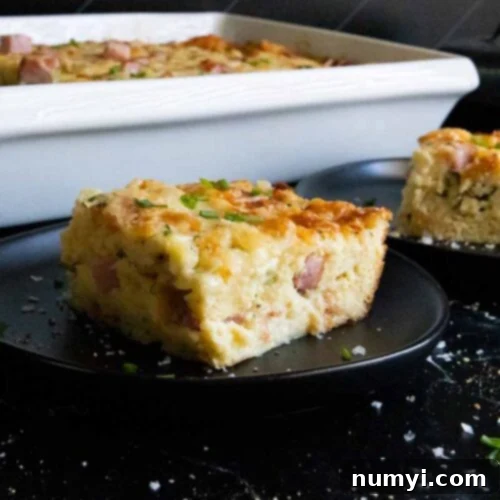
Ham and Cheese Strata
Print
Pin
Rate
Ingredients
- 2 tbsp Unsalted butter
- 1 cup Onion diced small
- 8 cups Italian bread torn into 1-inch pieces, or cubed (day-old bread works best!)
- 2 cups Smoked ham diced into 1/4-inch pieces (about 10 ounces, great for holiday leftovers)
- 2 cups Gruyere cheese shredded (reserve 1/2 cup for topping if desired)
- 1/4 cup Pecorino Romano grated
- 8 large Eggs
- 1 1/2 cups Whole milk
- 1/2 cup Heavy cream
- 2 tbsp Fresh chives diced (optional, for flavor and color)
- 1/2 tsp Dried thyme
- 1/2 tsp Ground mustard (adds a unique tangy flavor)
- 1 1/2 tsp Kosher salt
- 1/4 tsp Black pepper
Instructions
-
In a small skillet over medium heat, melt the butter, and saute the diced onions for about 8 to 10 minutes or until soft and translucent. Remove from the heat and allow to cool completely to prevent cooking the eggs prematurely.2 tbsp Unsalted butter, 1 cup Onion
-
Thoroughly butter a 9×13 baking dish to prevent sticking. Set it aside for later assembly.
-
In a large mixing bowl, combine the torn bread pieces (or cut bread cubes), the diced smoked ham, and the cooled sautéed onions. Toss these ingredients lightly to ensure they are well mixed and the onions are further cooled.8 cups Italian bread, 2 cups Smoked ham
-
Add 1 1/2 cups of the shredded Gruyère cheese and all of the grated Pecorino Romano cheese to the bread mixture. Toss well to combine everything evenly. (Note: You can add all 2 cups of Gruyère cheese to the mixture at this time if you prefer, instead of reserving 1/2 cup to sprinkle over the top during baking for a melted crust.)2 cups Gruyere cheese, 1/4 cup Pecorino Romano
-
In another bowl, whisk together the eggs, whole milk, heavy cream, fresh chives (if using), dried thyme, dry ground mustard, kosher salt, and black pepper until all ingredients are well combined and the mixture is smooth.8 large Eggs, 1 1/2 cups Whole milk, 1/2 cup Heavy cream, 2 tbsp Fresh chives, 1/2 tsp Dried thyme, 1/2 tsp Ground mustard, 1 1/2 tsp Kosher salt, 1/4 tsp Black pepper
-
Pour the prepared egg mixture evenly over the bread mixture in the large bowl. Gently fold all the ingredients together with a spatula, ensuring that every piece of bread is thoroughly coated and submerged in the custard.
-
Transfer the entire mixture into the prepared 9×13 baking dish, spreading it evenly and smoothing the top. Cover the baking dish tightly with plastic wrap. Refrigerate the strata overnight, or for at least 6 hours, to allow the bread to fully absorb the custard and for the flavors to develop.
-
When you are ready to bake, remove the strata from the refrigerator and let it sit at room temperature for at least 30 minutes before placing it in the oven. This helps ensure even cooking. Preheat your oven to 350 degrees F (175 degrees C). Remove the plastic wrap and cover the baking dish with aluminum foil, lightly spraying the underside of the foil with nonstick cooking spray to prevent sticking.
-
Bake the strata, covered, for 30 minutes. The foil helps to steam the casserole, keeping it moist and allowing it to puff up beautifully.
-
After 30 minutes, remove the foil. If you reserved 1/2 cup of Gruyère, sprinkle it over the top now. Continue baking for an additional 30 minutes, or until the strata is lightly browned, visibly puffed up, and a knife inserted into the center comes out clean.
-
Let the baked strata cool for 15 minutes before slicing and serving. This resting period is essential for the strata to set properly, ensuring clean, firm slices.
Notes
- Stale Bread is Best: For an optimal ham and cheese strata that is moist and custardy, not soggy, it’s crucial to use day-old or slightly stale bread. This type of bread readily absorbs the egg custard. If you only have fresh bread, simply tear or cube it and leave it out at room temperature overnight to dry out slightly, or lightly toast it in the oven at 300°F (150°C) for 10-15 minutes.
- Cheese Topping Preference: As noted in the instructions, you have the option to add all 2 cups of the Gruyère cheese directly into the bread mixture. However, we often prefer to reserve 1/2 cup to sprinkle over the top during the last 15-20 minutes of baking. This creates a beautiful, melted, golden-brown crust that adds an extra layer of texture and visual appeal to your strata.
- Checking for Doneness: To ensure your strata is perfectly cooked through, look for a golden-brown, puffed-up appearance. You can also gently give the pan a slight jiggle – if the center appears set and no longer liquidy, it’s done. A more traditional method is to insert a knife or thin skewer into the very center; if it comes out clean with no raw egg residue, your ham and cheese strata is ready to be enjoyed!
